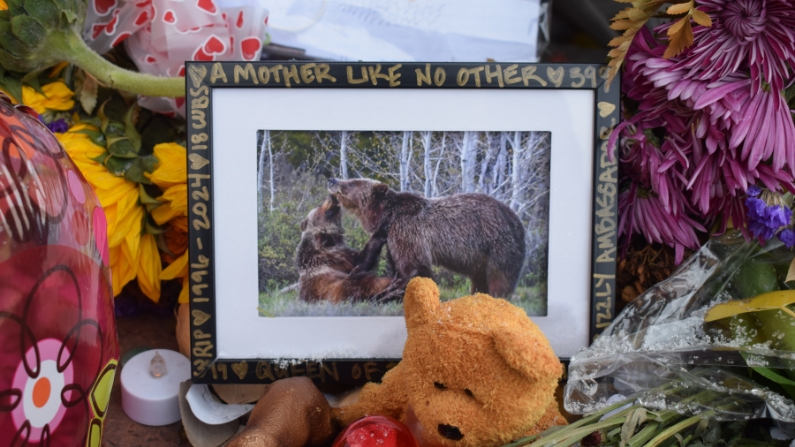The typically busy boardwalk around Jackson’s Town Square sat empty except for a memorial for Grizzly 3-9-9 about a week after her death. Fallen snowflakes melted as they touched the bouquets, pictures, hand-written notes and stuffed animals left by residents that boast the bear as the “queen of the Tetons” and a “mother like no other.”
It’s one of several ways people worldwide are mourning the bear’s death.
Kristin Combs, leader of Wyoming Wildlife Advocates, said she cried when she heard 399 had died.
“She’s had so much of a positive impact on so many people’s lives,” Combs said. “I mean, even people that have never seen her love her.”
She said the beloved bear — who had 18 cubs in her 28 years — has been an “ambassador” for the species, shifting popular images of grizzlies from a dangerous predator to a place of reverence. As well as guiding federal, state and local management policy to promote coexistence between humans and the species.
“I think that is the really powerful legacy that she leaves behind,” Combs said.
Chris Servheen agrees. He led the grizzly bear recovery effort for the US Fish and Wildlife Service for over 30 years and said 399’s visibility and fanfare were a pillar of conservation efforts for the species, which have successfully recovered from their “endangered” status, to “threatened” according to the U.S. Fish and Wildlife Service.
But Servheen said 399 was a management anomaly for grizzlies. The bear’s notoriety came from her visibility and mostly conflict-free life spent close to people. That, Servheen said, was part luck, part skill.
“Not every bear is that way,” Servheen said. “We must recognize that not every bear is as tolerant as 399.”
Servheen said human conflicts are one of the biggest threats to the Grizzly’s continued recovery in the Lower 48. And 399’s habitat beneath the Tetons is hazardous.
“That is a real minefield of human attractants,” Servheen said.“She was in a very risky environment and we always kept our fingers crossed and hoped for the best for her. And finally, unfortunately, her luck ran out.”
Every year Wyoming Game and Fish, and agencies in other states, relocate or kill bears deemed too habituated to humans or “unsuitable” for release into the wild.
“Literally hundreds and hundreds of new residents are moving in every year into grizzly bear habitat,” Servheen said, “and as these people move in there’s an increased risk for conflicts.”
So although Grizzly 399 largely avoided run-ins with humans, she has come close to humans and attractants, including wandering through downtown Jackson with her four cubs in 2021. Servheen said that’s one example where her fame lent her more leeway.
“She was given a lot of deference by the management agencies because of who she was,” Servheen said. “She was very visible and everybody got to know her.”
Servheen said it was a matter of time before her proximity to humans put her life at risk.
“We always dreaded the day that she might get into repeated trouble and have to be removed,” he said. “It was something that kept us awake at night.”
Dan Thompson, who leads the large carnivore department at Wyoming Game and Fish, said most of 399’s life was lived in Grand Teton National Park. The expanse of protected public land she inhabited made her management different from other grizzlies that live between private and public land.
“We’re not idiots,” Thompson said, “we know that there was worldwide attention towards this bear, which makes things more difficult from a consistency standpoint in managing grizzly bears.”
While 399’s life has brought up questions of management, in the wake of her death, Thompson said people should be given time to mourn.
“I think there are some bigger discussions we could have as far as their behavior and proximity to people, habituation, the celebrity-type status of bears,” Thompson said, “But I don’t think the time is right to start some of those larger conversations.”






